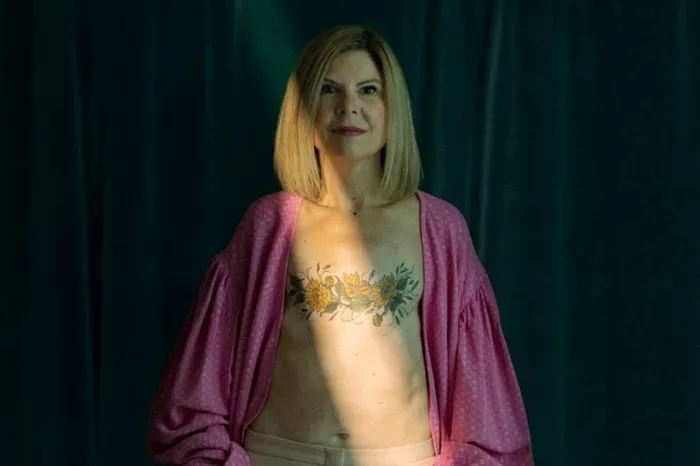Kim MacDonald, a veteran broadcaster with The Weather Network, breast cancer survivor, and national spokesperson for Breast Cancer Canada, showcases her double mastectomy scar adorned with a sunflower tattoo.
During her keynote address at the Luncheon of Hope fundraising event on September 24, MacDonald shared the story behind her tattoo and her decision to reveal it to the public. The 26th annual Northern Cancer Foundation event has raised over $1.1 million for cancer care and research at the Shirley and Jim Fielding Northeast Cancer Centre, with hopes of adding another $60,000 this year.
After undergoing a double mastectomy in 2017, her oncologist advised her to wait three years before considering reconstructive surgery due to the aggressive nature of her cancer and the risk of recurrence. Thus, MacDonald chose to remain flat, a decision she felt was right for her. On the fifth anniversary of her surgery in 2022, she decided to cover her scars with artwork.
“I wanted a tattoo of sunflowers, and so I got one,” she explained. “There’s a saying: ‘Be the sunflower, stand tall and follow the sun.’ That’s what I’ve been striving to do since my breast cancer diagnosis. With this tattoo, I felt transformed; I learned to accept my body as it was, and that was okay. This tattoo made me feel beautiful, strong, and a bit of a badass.”
While searching for examples of tattoo artwork over scars online, MacDonald found few resources. Despite her initial hesitation, she agreed to have her tattoo featured in an advertising campaign.
“I wanted to show breast cancer patients what was possible and normalize this body to society,” she said. “I was scared. This was the most vulnerable thing I’ve ever done.”
Diagnosed with Stage 2b Invasive Ductal Carcinoma, HER2+ at the age of 48 in late 2016, MacDonald sensed something was wrong before receiving her diagnosis. Her right breast had hardened, developed a rash, and her nipples retracted.
Her tumor measured 10 centimeters—about the size of a baseball—necessitating chemotherapy to shrink it before surgery. Although the chemotherapy successfully reduced the tumor, MacDonald still underwent a double mastectomy to minimize the risk of recurrence.
Due to her HER2+ diagnosis, she also had a port implanted in her chest for Herceptin injections. MacDonald believes that without Herceptin, a drug available in Canada since 2000 that effectively combats certain breast cancers, she may not be alive today.
She emphasizes the importance of early detection, highlighting that mammograms have become more accessible for women in their 40s in Ontario. “I want people to know that breast cancer can be curable if found early enough,” she stated. “The survival rate for Stage 0 is 99%, while Stage 4 is only 31%, though that number is improving due to research. So, get screened and ask questions. Breast cancer can affect women of any age—it’s not just an older woman’s disease.”
MacDonald also discussed the vital role of breast cancer survivors in raising awareness and understanding of the disease, emphasizing that one doesn’t need to be a national broadcaster to make an impact.
She recounted one of her darkest moments during chemotherapy, when she lay weak and bald on her bathroom floor, unsure if she could rise. But she did, and she is grateful for that.
“On your darkest days, when everything feels impossible, be brave, find your voice, and speak up, because you never know how it can help you or someone else,” MacDonald advised.
At the Luncheon of Hope event, Dr. Abhenil Mittal, a medical oncologist in Sudbury, discussed the significant advancements in breast cancer research over the years. “Remarkable progress has been made across all aspects of treatment in the last few decades,” he noted. “Overall, mortality from breast cancer has declined by more than 50% compared to the 1990s. Generally, 90% of women diagnosed with breast cancer live more than five years. Furthermore, advancements in surgical techniques, radiation planning, and drug delivery have made treatments much better tolerated. All of this progress is thanks to collaborative research, funded through generous donations and the participation of patients in clinical trials.”
Related Topics

